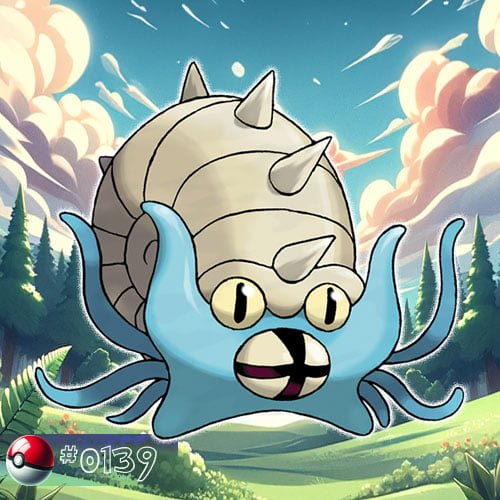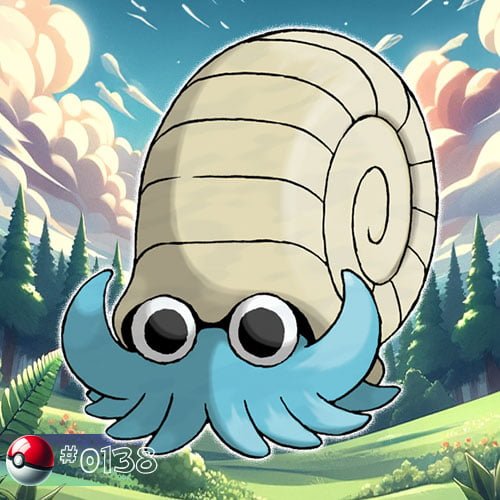Omastar
Omastar is a Rock/Water-type Pokémon originating from the Kanto region. It is the evolved form of Omanyte and is known for its shell-covered body and ancient origins.
Biology
Physical Characteristics
Omastar possesses a distinctive anatomical structure that reflects its adaptation to its aquatic habitat. Its most prominent feature is its spiral-shaped shell, which serves as both protection and a buoyancy aid. The shell is composed of a series of interlocking plates, giving it a rigid and durable structure. Along the edges of the shell are numerous pointed spikes, which likely serve as a deterrent to predators.
The body of Omastar is relatively compact, with a pale blue-gray coloration that provides effective camouflage in its underwater environment. It has a large, circular mouth with sharp teeth, indicating a predatory diet. This mouth structure suggests that Omastar is an active hunter, capable of capturing and consuming prey items such as small fish and aquatic invertebrates.
Omastar has four tentacles emerging from its body, each equipped with a single red eye at the base. These eyes are highly sensitive to light and motion, allowing Omastar to detect prey and potential threats in its surroundings. The tentacles also possess suction cups, which enable Omastar to anchor itself to rocks and other surfaces in fast-moving currents, providing stability and maneuverability.
Overall, Omastar’s physical characteristics represent a remarkable adaptation to its aquatic lifestyle, allowing it to thrive in the depths of the ocean millions of years ago.
Behaviour
Omastar, with its ancient origins and unique physiology, exhibits fascinating behaviors that reflect its adaptation to its aquatic environment:
As a predatory Pokémon, Omastar likely employs a variety of hunting strategies to capture prey. Its sharp teeth and powerful jaws suggest that it may ambush smaller aquatic creatures or actively pursue them in open water. Omastar’s tentacles, equipped with sensitive eyes and suction cups, likely aid in locating and capturing prey items with precision. Omastar may exhibit territorial behavior, especially around areas rich in food resources or suitable nesting sites. It could defend its territory from intruders, using its sharp shell and tentacles as defensive weapons if threatened.
While little is known about Omastar’s social behavior, it may interact with other members of its species during mating seasons or when competing for resources. However, as a Pokémon that lived millions of years ago, its social structure remains largely speculative.
Some studies suggest that Omastar may be nocturnal, becoming more active during the night to hunt or engage in other behaviors. This nocturnal activity pattern could be an adaptation to avoid predators or exploit prey that are more active during the nighttime hours.
Like modern cephalopods, Omastar likely laid eggs in aquatic environments. It may have exhibited parental care behaviors, such as guarding its eggs or young, to ensure their survival until they were capable of fending for themselves.
Overall, Omastar’s behavior would have been influenced by its status as a marine predator, its need to secure food resources, and its interactions with other aquatic Pokémon in its ancient ecosystem.
Evolution
Omastar’s evolution is a fascinating process that highlights its ancient origins and adaptation to its environment.
Omastar belongs to a unique group of Pokémon known as Fossil Pokémon. It evolves from Omanyte, another Fossil Pokémon, after being resurrected from the Helix Fossil using modern technology. This process involves extracting genetic material from the fossilized remains and cloning the Pokémon back to life.
Omanyte and its evolution line are based on prehistoric marine creatures known as ammonites. These ancient cephalopods lived millions of years ago in Earth’s oceans. The evolutionary line of Omanyte and Omastar reflects the real-world process of fossilization and extinction followed by resurrection through scientific advancement in the Pokémon world.
Omanyte evolves into Omastar starting at level 40. This progression suggests that Omastar undergoes significant physiological changes as it matures, transforming from a smaller, spiral-shelled Pokémon into a larger, more formidable creature with a distinct shell structure and tentacles.
One of the most notable changes during evolution is the development of Omastar’s iconic shell. While Omanyte possesses a small, coiled shell, Omastar’s shell becomes larger, flatter, and more robust. This shell serves as protection against predators and provides structural support for Omastar’s body.
As Omastar evolves, it gains access to more powerful moves and abilities compared to its pre-evolved form. This enhancement in capabilities reflects Omastar’s increased size, strength, and maturity, allowing it to better thrive in its aquatic habitat.
Omastar’s evolution from Omanyte symbolizes the resilience of life and the ability to adapt to changing environments, even across millions of years of evolutionary history.
Appearances
Anime Main Appearances
In “Attack of the Prehistoric Pokémon”, two Omastar lay dormant until a dynamite blast woke them. They chased Ash and Team Rocket until Aerodactyl intervened. In “Fossil Fools”, multiple Omastar were found in the Ruins of Alph alongside Omanyte. They were relocated to a museum.
In “Dealing With Defensive Types!” an Omastar caught Team Rocket pilfering from the Canalave Gym kitchen and sent them blasting off with Water Gun. In HZ035, a Pokémon hunter owned an Omastar.
Anime Minor Appearances
In ”Pikachu’s Vacation”, an Omastar was spotted at the Pokémon Theme Park. Team Rocket fantasized about an Omastar in ”Imitation Confrontation”. Omastar made appearances in fantasies in ”A Ruin with a View” and ”Where’s Armaldo?”.
In ”Lucario and the Mystery of Mew”, one dwelled in the Tree of Beginning and another featured in the opening sequence. Dr. Yung utilized a Mirage Omastar in ”The Mastermind of Mirage Pokémon”. Additionally, an Omastar made an appearance in ”Restore and Renew!”.
Manga Appearances
Pokémon Adventures
Yellow acquired an Omastar named Omny from Misty, starting as an Omanyte. Omny evolved into an Omastar in ”The Might of… Metapod?!”.
Pokémon Pocket Monsters
In this manga Omastar appeared in ”Big Rampage at the Safari Zone!?” (evolved from an Omanyte), ”Clefairy Evolves… At Last?!” and ”The Ancient Pokémon Discovery!”.
Game data
Stats
Location
| Game version | Location |
|---|---|
| Pokémon Red and Pokémon Blue | Evolve Omanyte |
| Pokémon Yellow | Evolve Omanyte |
| Pokémon Gold and Pokémon Silver | Time Capsule |
| Pokémon Crystal | Time Capsule |
| Pokémon Ruby and Pokémon Sapphire | Trade |
| Pokémon FireRed and Pokémon LeafGreen | Evolve Omanyte |
| Pokémon Emerald | Trade |
| Pokémon Colosseum | Trade |
| Pokémon XD | Trade |
| Pokémon Diamond and Pokémon Pearl | Evolve Omanyte |
| Pokémon Platinum | Evolve Omanyte |
| Pokémon HeartGold | Evolve Omanyte |
| Pokémon SoulSilver | Trade |
| Pokémon Black and Pokémon White | Evolve Omanyte |
| Pokémon Black 2 and Pokémon White 2 | Evolve Omanyte |
| Pokémon X | Trade |
| Pokémon Y | Evolve Omanyte |
| Pokémon Omega Rubya | Trade |
| Pokémon Alpha Sapphire | Evolve Omanyte |
| Pokémon Sun and Pokémon Moon | Trade |
| Pokémon Ultra Sun and Pokémon Ultra Moon | Evolve Omanyte |
| Pokémon: Let's Go, Pikachu! and Pokémon: Let's Go, Eevee! | Evolve Omanyte |
| Pokémon Sword and Pokémon Shield | Trade |
| Pokémon Brilliant Diamond and Pokémon Shining Pearl | Evolve Omanyte |
| Legends Arceus | Unobtainable |
| Pokémon Scarlet and Pokémon Violet | Unobtainable |
Omastar's origin name
English: In English, Omastar’s name is a combination of “Omar” and “star”, possibly referencing its ancient origins and its celestial appearance due to its spiral shell.
Japanese: オムスター (Omusutaa) – This name is a phonetic rendering of its English name “Omastar”.
French: Amonistar – A combination of “ammonite”, the real-life fossil creature Omastar is based on, and “star”.
German: Amoroso – A combination of “Ammonit”, the German word for ammonite, and “oso,” which means “bone” or “ossein”.
Spanish: Omastar – Retains the same name as its English counterpart.
Italian: Omastar – Also, retains the same name as its English counterpart.
Korean: 옴스타 (Omseuta) – Similar to the Japanese name, this is a phonetic rendering of “Omastar”.
Chinese (Simplified): 大菊石 (Dà Júshí) – Translates to “Big Ammonite”, referring to its prehistoric inspiration.
Chinese (Traditional): 大菊石 (Dà Júshí) – The same as the Simplified Chinese name, also meaning “Big Ammonite”.
These names in various languages often reflect Omastar’s ammonite-based design and its status as a powerful, star-shaped Pokémon.




